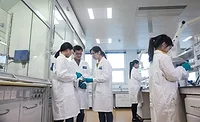BASF Keeps R&D Spending at High Level
BASF has announced that it intends to maintain its research budget in 2010 at the previous years’ high level, with an overall target of EUR 1.38 billion.
LUDWIGSHAFEN, Germany - BASF has announced that it intends to maintain its research budget in 2010 at the previous years’ high level, with an overall target of EUR 1.38 billion. This was confirmed by Andreas Kreimeyer, Member of the Board of Executive Directors and Research Executive Director, at the company’s Research Press Conference on Jan. 28, 2010, in Ludwigshafen, Germany. For 2009, BASF’s research allocations reached almost EUR 1.4 billion, slightly above the 2008 level of EUR 1.35 billion.
“Only with a continuous flow of innovations can we consistently use competitive advantages to achieve above-market organic growth. Continuity of research strategy is important both in good times and also in times of crisis,” said Kreimeyer. The company's R&D strategy aims to enhance the existing portfolio, develop customer-specific system solutions and deliver solutions to the challenges of the future arising from global megatrends. The issues to be addressed include supplying a growing world population with water, food, energy or mobility. Reflecting these technology and chemistry-relevant global trends, BASF has defined five growth clusters for strategic corporate research: Plant Biotechnology, White (Industrial) Biotechnology, Nanotechnology, Energy Management and Raw Material Change.
Kreimeyer also noted that it will be necessary to respond to the paradigm shift currently underway in chemistry, whereby success will no longer be determined merely by new molecules but by new effects, new systems and system solutions, new components, and functional materials. “We can only successfully tackle these complex problems through international and interdisciplinary cooperations,” he explained.
The importance of international knowledge networks in tackling the challenges of the future was demonstrated by presenting three of BASF’s particularly successful research cooperations. These were: the Joint Innovation Lab at the Ludwigshafen site, which is pushing forward organic electronics; the research initiative at Harvard University in the United States, which is devoted to preventing biofilms; and the Catalysis Research Laboratory (CaRLa) at Heidelberg University.
Looking for a reprint of this article?
From high-res PDFs to custom plaques, order your copy today!




